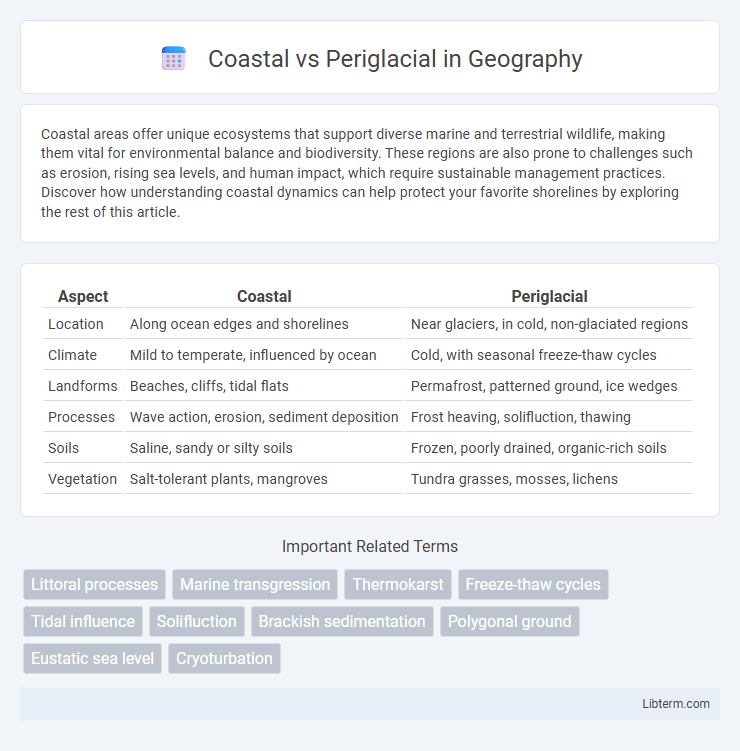Coastal areas offer unique ecosystems that support diverse marine and terrestrial wildlife, making them vital for environmental balance and biodiversity. These regions are also prone to challenges such as erosion, rising sea levels, and human impact, which require sustainable management practices. Discover how understanding coastal dynamics can help protect your favorite shorelines by exploring the rest of this article.
Table of Comparison
| Aspect | Coastal | Periglacial |
|---|---|---|
| Location | Along ocean edges and shorelines | Near glaciers, in cold, non-glaciated regions |
| Climate | Mild to temperate, influenced by ocean | Cold, with seasonal freeze-thaw cycles |
| Landforms | Beaches, cliffs, tidal flats | Permafrost, patterned ground, ice wedges |
| Processes | Wave action, erosion, sediment deposition | Frost heaving, solifluction, thawing |
| Soils | Saline, sandy or silty soils | Frozen, poorly drained, organic-rich soils |
| Vegetation | Salt-tolerant plants, mangroves | Tundra grasses, mosses, lichens |
Introduction to Coastal and Periglacial Environments
Coastal environments are dynamic zones where land meets the ocean, influenced by tides, waves, and marine processes. Periglacial environments, found near glacial regions, are characterized by freeze-thaw cycles and permafrost affecting soil and landscape formation. Understanding these environments involves examining factors like climatic conditions, geomorphological processes, and ecosystem adaptations unique to each setting.
Defining Coastal Regions
Coastal regions are defined by their proximity to oceans, seas, or large bodies of water, where dynamic interactions between land and marine environments occur. These zones experience processes such as wave action, tidal fluctuations, and sediment deposition, shaping distinct landscapes like beaches, cliffs, and estuaries. In contrast, periglacial regions are characterized by freeze-thaw cycles and permafrost conditions, primarily found near glacial environments rather than coastal boundaries.
Understanding Periglacial Zones
Periglacial zones are characterized by intense freeze-thaw cycles that significantly shape the landscape through processes like solifluction and frost heave, differentiating them from coastal environments that are dominated by marine influences. These areas typically appear adjacent to glacial regions and experience permafrost, which controls soil structure and vegetation patterns. Understanding periglacial zones involves analyzing soil temperature dynamics, seasonal thaw depths, and geomorphological features such as patterned ground and ice wedges.
Key Characteristics of Coastal Areas
Coastal areas are defined by their proximity to oceans or seas, featuring dynamic environments shaped by waves, tides, and saltwater influence, which support diverse ecosystems such as mangroves and coral reefs. These regions typically experience moderate temperatures, high humidity, and distinct salinity gradients that affect soil formation and vegetation patterns. Human activity in coastal zones often includes fishing, tourism, and urban development, necessitating sustainable management due to erosion and sea-level rise challenges.
Major Features of Periglacial Landscapes
Periglacial landscapes are characterized by extensive permafrost, patterned ground, and frost heave phenomena, resulting from intense freeze-thaw cycles in cold climates. These areas exhibit solifluction lobes, ice wedges, and pingos, which distinguish them from coastal environments shaped primarily by wave action and tidal processes. The predominant geomorphic processes in periglacial zones include cryoturbation and gelifluction, influencing soil structure and surface morphology significantly.
Climate Influences on Coastal vs Periglacial Regions
Coastal regions experience milder temperatures and higher humidity due to proximity to large water bodies, influencing weather patterns with sea breezes and salt-laden air. Periglacial regions are characterized by extreme cold climates, with frequent freeze-thaw cycles causing ground frost and patterned ground formations. Climate influences in coastal areas promote diverse ecosystems, while periglacial climates shape unique geomorphological features and limit vegetation growth.
Common Landforms in Coastal vs Periglacial Settings
Coastal environments feature landforms such as beaches, cliffs, dunes, and spits shaped by wave action, tidal processes, and sediment deposition. Periglacial settings are characterized by patterned ground, ice wedges, solifluction lobes, and pingos resulting from freeze-thaw cycles and permafrost dynamics. Both settings show distinct geomorphological features driven by their unique climatic and environmental conditions.
Human Activities in Coastal and Periglacial Areas
Human activities in coastal areas are dominated by tourism, fishing, shipping, and urban development, driven by access to marine resources and transportation routes. In periglacial areas, human presence is limited but includes scientific research, limited mining, and indigenous subsistence practices, constrained by extreme cold and seasonal permafrost. Coastal zones face challenges such as erosion and habitat loss due to infrastructure expansion, while periglacial regions experience impacts from thawing permafrost affecting construction and traditional lifestyles.
Environmental Challenges: Erosion and Climate Change
Coastal environments face severe erosion due to rising sea levels and increased storm frequency caused by climate change, threatening habitats and human settlements. Periglacial regions experience permafrost thawing, resulting in ground instability and carbon release that exacerbate global warming. Both regions require targeted mitigation strategies to address their unique erosion patterns and climate vulnerability.
Conclusion: Comparing Coastal and Periglacial Dynamics
Coastal dynamics are primarily driven by marine processes such as wave action, tidal currents, and sediment transport, resulting in features like beaches, cliffs, and estuaries. In contrast, periglacial dynamics are dominated by freeze-thaw cycles, frost heaving, and ice wedge formation, shaping landscapes through processes like solifluction and patterned ground development. Understanding the distinct mechanisms and environmental factors influencing coastal and periglacial environments is essential for predicting landscape evolution and managing natural hazards in these regions.
Coastal Infographic

 libterm.com
libterm.com